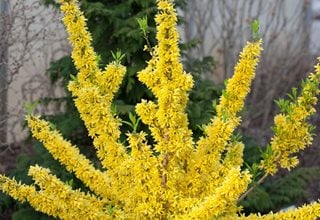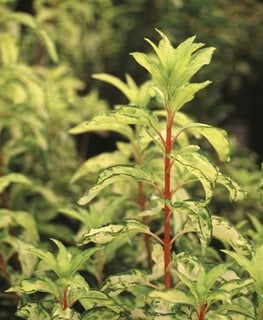How to Grow and Care for Forsythia Bushes
Add this reliable favorite for early spring color Updated: 1/18/2022A true sign of spring, forsythia is one of the first shrubs to bloom, providing a burst of color when gardeners need it most. The bright yellow flowers often start blooming even when there’s still snow on the ground. This versatile plant can be used in a variety of ways, from a single focal point to hedging or foundation plantings.
This tough deciduous shrub thrives in a wide range of conditions, and can be grown in most regions. Hardier varieties are recommended in northern climates where flower buds may be damaged from extreme cold or temperature fluctuations. Newer cultivars have been bred for compact stature more suitable to urban lots, as well as unusual foliage and colored stems that lend multi-seasonal interest in the landscape.
On this page: Basics | Planting | Care | Varieties | FAQ's | Design Ideas | Forcing Bloom
On this page:
- BASICS
- HOW TO PLANT FORSYTHIA
- FORSYTHIA CARE AND PRUNING
- FORSYTHIA PICTURES
- FREQUENTLY ASKED QUESTIONS
- DESIGN IDEAS
- HOW TO FORCE BRANCHES TO BLOOM INDOORS
FORSYTHIA BASICS
Zones:
3-9
Height/Spread:
Upright arching habit, 1 to 20 feet tall and 3 to 10 feet wide
Exposure:
Full sun to partial shade; blooms most in full sun.
Bloom time:
Early-mid spring
Color and characteristics:
Grown primarily for the bright yellow blooms along the length of the branches in early spring before the foliage appears. Leaves are green or variegated, and pointed with a serrated edge. Fall foliage is generally insignificant, though it can take on purple, red, or yellow tinges.
Is forsythia poisonous?
All parts of forsythia are non-toxic to dogs and cats. (See more plants that are safe for pets.)
Is forsythia deer resistant?
Deer will leave forsythia alone for the most part, though extreme conditions can result in deer grazing on plants they wouldn’t otherwise. See more deer-resistant plants for your garden.
PLANTING FORSYTHIA
When to plant:
Plant during milder months of spring or fall to avoid heat or cold stress.
Where to plant:
Choose a sunny to lightly shaded site with fertile, well-draining soil that will stay evenly moist.
How to plant:
Loosen soil and work in compost. Remove plant from container and gently tease out roots or slice the rootball in several places if potbound. Dig a hole twice as wide as the rootball and deep enough so the top of the rootball is slightly above or level with the surrounding soil surface; avoid planting too deep. Backfill the hole, gently tamp down soil around the base and water well.
Spacing:
Depends on the variety; allow for adequate air circulation for healthy plants.
FORSYTHIA CARE & PRUNING
Pruning forsythia:
Forsythia shrubs are fast-growing and require regular pruning to retain an attractive appearance. They are best pruned in a way that retains their natural arching shape.
- Forsythia flowers bloom on old wood and should be pruned just after flowering to preserve next year's blooms.
- Annually: Using a pair of loppers, remove dead branches and shape as needed after flowering.
- Every 2 to 3 years: Before plants break dormancy in late winter, thin out 1/4 to 1/3 of the oldest stems, cutting back close to the ground to open up the center of the shrub and improve air circulation.
- Trimming the stems only part way down will result in new branching just below the cut, causing overly dense foliage, with flowers only occurring at the tips.
- Pruning or shearing them into a hedge will often result in a loss of flowers and the resulting dense growth habit may also increase the risk of fungal disease.
- Overgrown plants can be rejuvenated by lopping the entire plant to several inches above the ground.
Watering:
Though somewhat drought tolerant once established, forsythia does best with regular watering. Irrigate newly planted specimens once or twice a week; once established, water as needed during hot, dry spells. Take care not to overwater, which can cause root rot or make plants more susceptible to disease.
Soil:
Forsythias are tolerant of a wide range of soil conditions, but prefer well-draining soil amended with rich organic matter. Ideal pH ranges from 6.8 to 7.7.
Amendments & fertilizer:
When soil is properly amended and maintained, forsythia needs little to no supplemental fertilizer. If desired, apply a slow-release fertilizer for trees and shrubs in early spring, according to package instructions. Mulch with 1 to 2 inches of organic matter to retain moisture and suppress weeds.
Pests and diseases:
When planted in optimal conditions, forsythia exhibits few, if any problems. Possible fungal diseases include anthracnose, leaf spot and yellow leaves. Pests include aphids, Japanese weevil, and nematodes. To discourage problems, keep areas around plants clean, provide good air circulation, and minimize overhead watering.
FORSYTHIA VARIETIES
FREQUENTLY ASKED QUESTIONS
Is forsythia invasive? Forsythia is not on the USDA invasive plant list, but it does have its challenges. If the branches touch the ground, they can root and start new plants. Also, the roots can be difficult to eradicate if removal of the shrub is desired.
Do bees and butterflies like forsythia? Forsythia blooms early in the season before most bees and butterflies are active. Since it’s not native to the US, forsythia is not generally regarded as a beneficial pollinator plant. There may be some insect activity around the blooms in warmer regions where insects emerge earlier.
Why is my forsythia not blooming? There are many reasons why your forsythia isn’t blooming. These can include:
- In colder regions, the flower buds may not survive a hard winter or late hard frost.
- Forsythia blooms on old wood. If plants are pruned in summer or fall, the growth that produces next year’s flowers may be removed. Prune plants just after flowering in early spring.
- Too much shade can result in few or no blooms. Forsythia needs at least 6 hours of full sun to flower.
- Plants may be too old. Forsythia may be rejuvenated by cutting out a third of the older canes or cutting plants back hard to the ground, but sometimes replacement with a new cultivar is the best option.
- If the crown is buried beneath the soil or heavily mulched, this may impair root development, depriving plants of nourishment which can result in failure to set buds.
- Drought stress can hinder flower bud development. Make sure plants receive regular water during warmer summer months.
- Too much nitrogen in the soil can produce lush foliar growth at the expense of flowers. If a forsythia shrub is sited near a lawn that is regularly fertilized, the high nitrogen content of lawn fertilizer may be hindering bud development. Use an all-purpose fertilizer especially formulated for trees and shrubs, or add fertilizer around the root zone such as bone meal that is high in phosphorus to offset the effects of nitrogen.
DESIGN IDEAS
There are many ways to incorporate forsythia into your landscape. Here’s how:
- Plant in the middle or back of a mixed border where the neutral green foliage lends a backdrop to plants with flowers or colored foliage.
- Plant a larger variety as hedging along a property line for privacy.
- Place a small to medium-sized variety along your home’s foundation in combination with other flowering shrubs such as azalea, abelia and bluebeard that bloom at different times throughout the growing season for continuous color.
- Naturalize larger specimens in a woodland border that can be seen from inside your home. Add bulbs such as species crocus and narcissus that will bloom at the same time and multiply over time.
- Mass a groundcover type along a bank or slope for erosion control.
HOW TO FORCE FORSYTHIA BRANCHES INTO BLOOM
Forsythia branches can be cut and brought indoors, even in the bud stage. Here’s how to get the most out of your late winter bouquet.
- Choose branches with plump buds 2 to 4 weeks before normal bloom time.
- Cut branches at least 12 to 18 inches long at a 45-degree angle to help stems absorb water.
- Trim off lower flower buds and side shoots that would sit below water level.
- Place branches indoors in a vase with lukewarm water and set in a bright location near a window.
- Change water every few days to keep bacteria from forming, which can cause branches to rot.
- Flowers may take from several days to a couple of weeks to open.
RELATED:
Shrubs 101
Best Flowering Shrubs for All-Season Color
17 Fast-Growing Shrubs for Your Garden
Growing Mock Orange Shrubs










